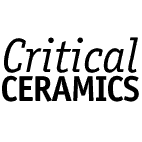



Work by Charles Brown

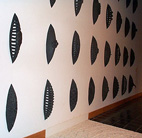
Work by Sadashi Inuzuka

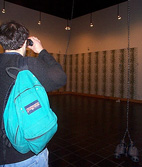
Work by Jennifer Lapham
A Review of Cooled Matter
Forrest J. Snyder
After reading Mitchell Merback's introduction in the catalog for Cooled Matter, (Columbus College of Art & Design, Joseph Canzani Center, Cleveland Ave. at E. Gay St., Columbus, OH, 614-224-9101, March 5 - April 16) the ceramic installation show timed to coincide with NCECA 1999, one might anticipate a broad, thought provoking and moving collection of works. What one encounters is something else altogether.
While there are six unique works created by six individual artists, by and large these works, and by inference, one wonders if these artists, subscribe to a very particular methodology of presentation which obscures to the point of defeat any great meaning. With one exception, as a bold statement of contemporary ceramic art within the greater context of installation sculpture this show disappoints.
Cooled Matter consists of works by five invited artists (Sadashi Inuzuka, Jennifer Lapham, Walter McConnell, Katherine Ross, and Garry Williams) and the organizing artist, Charles Brown. Each of these six created a substantial body of individual pieces that when assembled makes for a greater whole. In this show, there is much to be said for massing multiples. Although these six fill the gallery physically, only one successfully manages to create a psychological space all its own. Indeed with the singular exception, these works were highly formulaic.
This formula goes something like this:
1. Draw two series of widely spaced parallel horizontal and vertical lines.2. Where these lines intersect, or create squares, place coolly crafted and vaguely referential ceramic objects en masse.
3. To muddy the waters a bit, place wholly different items at calculated 'random' locations in opposition to the grid.
4. Said wholly different items should have, if possible, little outward relation to the repetitive bulk of the work.
5. Finally, give the entire conglomeration a scientific or academic sounding name.
With the exception of Walter McConnell's "Flora & Fauna", the remaining works remind the viewer of very clean, academic, graphic design. In each case, the artists have developed their own 'letter' forms which while they can be read as beautiful individual objects, fail to convey meaning when strung together. Like much academic graphic design, any meaning is secondary to subscribing to a particular design philosophy. Clearly, the letters are there, and with such stunning letters, something of importance must be being said, right? One hopes. As exemplified here, much of the message is beyond grasp, if present at all.
Katherine Ross has done an excellent job of creating an experiment that follows the afore mentioned formula. This work carries on her exploration of water and its ability to be polluter, cleanser, and healer. Ross choose a corner of the gallery for her piece. Her "Prophylaxis/Hygiene" has sections of both walls painted an institutional green. On the larger of the two, she has painted a large square, perhaps 16' x 16'. In front of this green field she's placed slip cast hot water bottles at the intersections of her invisible parallel lines (see formula above). On the opposite wall, the same sickly green paint highlights a long row of porcelain faucet handles, each of which has a word printed on it. All together they compose a phrase that alludes to water and it's character. On the floor, one encounters the 'random' bits used to offset the clarity of the grid. In Ross' case, she has placed groupings of white hospital tiles on the floor. Applied to each group of tiles are vastly enlarged virus. The effect is like something one might see when looking through a microscope. Taken as a whole, "Prophylaxis/Hygiene" gives the feeling of a cold, antiseptic, hospital which has been invaded by unwelcome pathogens. One should consider, however, if the message might not be better transmitted through other means. In particular, the casts of the hot water bottles are flat and lifeless. As clay objects, they are quite ambiguous. Obviously there is the clay vessel reference. Is there anything greater that demands that they be of ceramic? Actual rubber hot water bottles, casts in glass, or best yet, casts in ice, might be more adventurous and more meaningful. In "Prophylaxis/Hygiene", Katherine Ross has shown us clear, if not shallow, water. Maybe it's time to explore the depths where light fades.
Sadashi Inuzuka in his "Same Family" presents the most straight forward proof of the formula. Mr. Inuzuka has developed a concise vocabulary of reduction fired ceramic 'words'. Each of these words uses as its base form something akin to a boat hull. Within this framework, individual words are distinguished by unique organic components of body and protuberance. These pieces are hung on the wall in the strict confines of a large grid. On this wall the grid of objects seem lost. To be sure they're anchored, but anchored where? And for what purpose? An orderly grid alone cannot supply reason. In Inuzuka's case, the pseudo-random component is a large (approximately 4' x 16') plane of white slip poured out onto the gallery floor leading up to his wall. He does so to great effect to interrupt his audience, to force them to a new place. Viewers are prompted to walk around this runway in order to see the hanging pieces on the other side. Thus, as one travels from near to far to near again, one is forced to consider the individual components and the whole they compose. This interventionist strategy is quite successful. Furthermore, one cannot overlook the ever changing life of the slip itself. By virtue of its change, the slip points out the stasis of the fossilized organelles hanging on the wall. The slip is a signifier of time passing. The liquid clay dries, cracks, and flakes over time. "Same Family" reminds the viewer of place in time and space; unfortunately, further meaning is undistinguished.
Finally, one arrives at Walter McConnell's "Flora & Fauna". McConnell seems to reject the formula advocated by his colleagues. For this alone, he should be commended. Gladly, there is more importance to his work than simply being different.
Like Sadashi Inuzuka, Mr. McConnell has recognized the strengths in the materialness of raw clay - in his case terra cotta. The raw clay has been formed into an oval section on the floor. This mound is composed of prehistoric looking plants - meaty succulents, low lying flowers, ferns, and the like. This raw clay mass is literally and figuratively "of earth". This slice of time is held captive by being enclosed in a clear plastic column. Thus, McConnell doesn't completely abandon his colleagues scientific allusions, however. His mass is unfailing like a giant specimen jar. The audience is safe from the specimen, and it is safe from the modern day manufactured environment. The effect is not unlike that of a terrarium. The passage of time and nature's relationship to this phenomena is captured in the moist air of the enclosure and the rivulets of water dripping down its sides. Inside, one could feel the moisture on one's cheek and taste the earth on one's lips. Subtly, McConnell reminds us that these joys (and risks) are forbidden, not by some greater power, but rather ourselves. comfort and hygiene take precedence over real experience. In place of the living, messy, reality, McConnell has substituted cheap placeholders. Peering towards the specimen jar of real nature are pastel colored animals - slip cast turtles, bunnies, and squirrels. These avail themselves for our own close inspection for the closest we can get to nature is our created image of nature. Through these inferior objects one can infer what nature 'must be like'. These animals with their still attached oversized casting sprues and funnels point out our folly. By isolating ourselves from experiencing a reality over which we have little control, we have dulled our lives to mind numbing blandness.
Perhaps one shouldn't be so disappointed. After all, there are herds of so-called "Minnesota Potters" that are highly respected for their premise of working and the work they produce. The problem, in the case of Cooled Matter, is that these artists have been promoted as offering something new and unique that will enlarge the confines of the ceramic art world. Simply, with singular exception, they have failed to follow through on their promise.

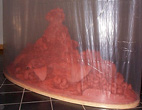
Work by Walter McConnell

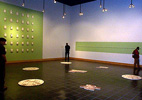
Work by Katherine Ross